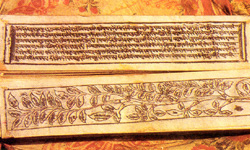 |
“In this age made totally dark By the five great
degenerations, The sentient being constantly tossed In waves of disease, sorrow
and pain. Thus Buddha, out of great compassion, Emanates as Bendurya, the
Medicine Guru. To shine as a sun in the skies of the world, And dry up the
water giving birth to all ills.” A Benediction to the Medicine Budddha. By
Gyalwa Kalzang Gyatso |
|
Originally,
Tibetan medicine dates back to the pre – Buddhist era. During the Bon Period,
various healing techniques were devised and practiced. With the coming of
Buddhism, medical knowledge became an integral part of religious doctrines and
monastic discipline. Buddha’s key teachings of the middle way between worldly
indulgence and self – denial gave wandering physicians of the period a
radically different view of the world and of humankind’s place in it; this was
further fostered by their intensely meditative discipline. Medicine thus became
a part of Buddhism – providing the means to maintain a healthy bodily state of
equilibrium.
Some have suggested that the
Buddha’s key teaching of the Four Noble Truths was based on a medical paradigm,
whereby suffering, its cause, its suppression, and the method for its
elimination find a parallel in midicine to disease, its cause, health and the
reedy. But actually the four fold division that occurs in Charaka Samhita is
different from the Four Noble Truths. “ The best physician, one fit to treat a
king, is he whose knowledge is four fold: (he knows) the cause (hetu), symptom
(linga), cure (prasmana), and non-recurrence (apunarbhava) of diseases.
Knowledge of medical theory and practice among the sarmanic, Buddhists,
however, is indisputable, and the Buddhist sangha, or monastic community where wandering
intellectuals would gather and exchange information, soon became the principal
vehicle for the preservation, advancement and transmission of medical lore.
Some of the repository of
medical lore was codified at these Sanghas, thereby giving rise to a Buddhist
medical monastic tradition. In the early Sangha, membership was quite
unrestricted and wanderers joined and left at will. These comings and goings
increased the volume of new information available. Debates among the temporary
residents were common and luckily included topics related to medicine. As fixed
Sangha establishments with permanent resident monks became more common, the
knowledge discussed and exchanged was gradually accumulated, filtered and
codified, eventually becoming Buddhist doctrine. The symbiotic relationship
between Buddhism and medicine led to the teaching of medicine in the large
conglomerate monasteries or viharas.
However, even after the
establishment of settled monasteries, medicines requisite in sickness remained
among the monk’s necessities and constituted one of his four possessions along
with a robe, a begging bowl, and a bed.
Tibetan medicine continued to
progress due to the efforts of Buddhist monks and the emphasis laid on
it by religion. In the process, it derived influences from various
external sources. In the second century A.D., it was further
influenced by arrival of two physicians from India by the names of Bijay and
Gazay. The Brahmin physicians Bijay was given the princess Cham – sing -
yekyireoja as his bride by King Lhatho – thori – nyentsen. Their son, named
Thung – ki – thorchok, too became a famous physician.
The development of the Tibetan
system got an impetus during the 7th and 8th centuries
when physicians from Persia, Greece, India, Nepal, China, Sinkiang and other
neighbouring states were invited to Tibet by the Kings Sorngstsen Gampa and
Trisong Detsen, to exchange knowledge with Tibetan scholars and physicians.
Many young Tibetans were enrolled as medical students and nine among them became
learned physicians. At this period the great Tibetan translator and scholar,
Beru Tsana (Vaircana) translated the
“Ghyushi” (Four Tantras) teachings given by the Kashmiri scholar Chandranandna
(Panchen Dawa Ngoenpa), into the Tibetan
language and presented the work to the king. Beside Beru Tsana, the
renowned Tibetan physician, Elder Yuthong Yonten Gompo (708 –833 A.D.) too
received the “Ghyu – Shi” teachings from India. It is said that the spread
of “Ghyu – shi” teachings was not ripe for revelation at that period and Guru
Padmasambhavahid the works, until Dapa
Ngoenshay revealed this hidden work from the top of the Samye Monastery in the
eleventh century.
For further information please Contact us !
|

